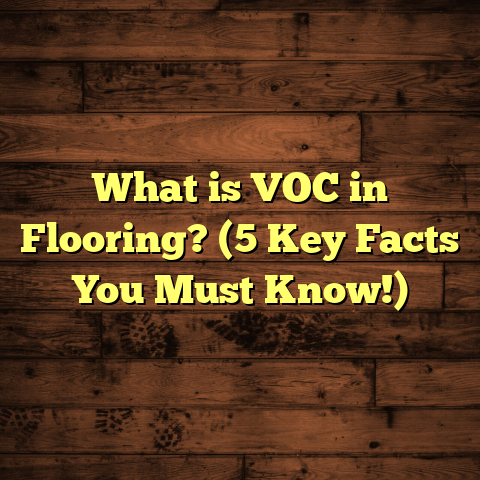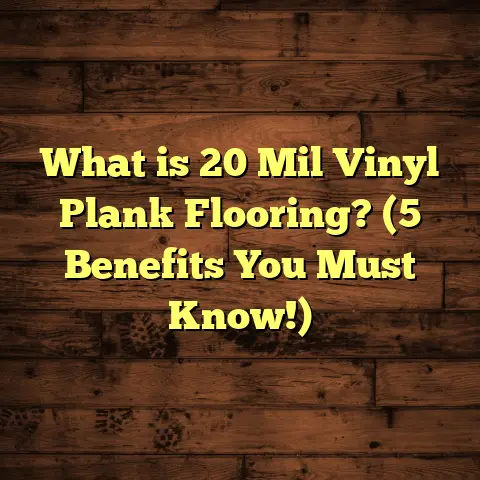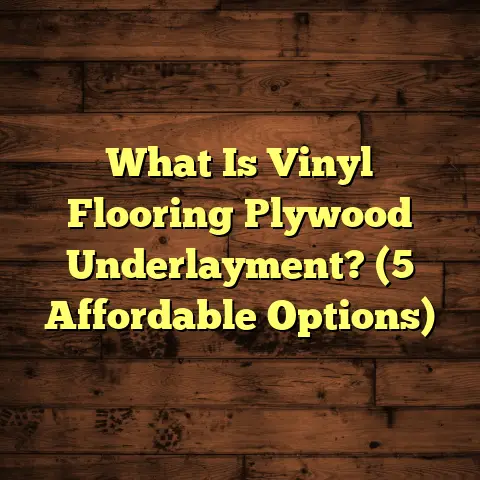What Is My Plastic Floor Called? (5 Types You Need to Know)
Would you rather have a floor that’s super easy to clean and lasts for decades, or one that looks amazing but needs constant care? If you’re scratching your head over your plastic floor and wondering what it’s actually called, you’re not alone. I’ve spent years working with all kinds of flooring, and plastic floors are a category that often confuses people because there are several types with different qualities, costs, and uses. Let me walk you through five main types of plastic floors you need to know about—and share some tips from my own experience to help you pick the right one.
What Is My Plastic Floor Called?
Plastic flooring is a broad term that covers any floor made from synthetic materials rather than natural wood or stone. These floors are usually chosen for their durability, water resistance, and affordability. But not all plastic floors are created equal. Depending on the material and construction, they can vary widely in look, feel, and performance. The five major types I encounter most often are vinyl sheet flooring, luxury vinyl tile (LVT), vinyl plank flooring (VPF), linoleum, and PVC tiles.
Let’s break down each type so you get a clear picture of what you have or what you need.
1. Vinyl Sheet Flooring: The Classic Plastic Floor
Vinyl sheet flooring is one big continuous roll of plastic—often flexible and waterproof. I remember installing this at a client’s kitchen where spills were constant because they had two kids under five. It handled everything from juice spills to muddy shoes without a scratch.
What makes it stand out?
- It’s seamless, which means fewer places for dirt or water to sneak through.
- Installation is pretty quick if you have a smooth subfloor.
- It’s budget-friendly; typically, it costs around $2 to $5 per square foot including installation.
Why I Recommend Vinyl Sheet Flooring Often
In my early years as a contractor, I used to think every floor needed to look like hardwood or tile. But after dealing with countless spills, scratches, and water damage claims, I realized vinyl sheet flooring is underrated. For example, a family I worked with had constant guest traffic mixed with their energetic kids, and the kitchen floor was always a mess. We installed vinyl sheet with a thick wear layer and cushioned backing. Two years later, they told me it still looked new despite daily abuse.
Vinyl sheet also excels in areas like laundry rooms or utility spaces. One challenge I faced was pouring concrete basement floors that were uneven. Vinyl sheet’s flexibility allowed us to cover minor imperfections without expensive leveling.
Installation Tips for Vinyl Sheet Floors
- Always check your subfloor for bumps and debris before laying the vinyl sheet.
- Leave a small gap around walls to allow for expansion.
- Use a roller during installation to ensure no air bubbles remain trapped.
- If you want extra comfort underfoot, consider adding foam underlayment beneath the vinyl sheet.
2. Luxury Vinyl Tile (LVT): Stylish and Practical
LVT looks like real wood or stone but it’s made from layers of plastic composites. Over the years, I’ve helped clients who wanted the upscale look of hardwood but needed something more durable and water-resistant.
What Makes LVT Different from Basic Vinyl?
The secret lies in its construction. LVT has multiple layers:
- A backing layer for stability.
- A core layer for strength.
- A high-resolution photographic layer that mimics wood or stone.
- A clear wear layer on top that protects against scratches and stains.
This wear layer is the real game-changer. When I specify LVT for commercial projects like boutique stores or restaurants, I always push for at least a 12-mil wear layer. It stands up well even under heavy foot traffic and furniture movement.
Real-World Example: LVT in Action
I recently completed a restaurant renovation where the owner wanted the ambiance of rustic hardwood but knew spills were inevitable. We installed an LVT floor with a 20-mil wear layer. After six months of busy service hours and spilled wine or sauces, the floor still looks flawless.
Cost Considerations With LVT
Prices vary based on thickness and design complexity. Some ultra-realistic planks can cost up to $10 per square foot without installation. But mid-range options usually fall between $3 and $7 installed, which is affordable compared to hardwood.
If you’re budgeting, remember:
- Higher wear layers cost more but last longer.
- Installation by pros ensures longevity—DIY can save money but risk mistakes.
- Some LVT products come with warranties up to 25 years—worth checking before buying.
3. Vinyl Plank Flooring: Wood Lookalike with Plastic Backbone
Vinyl plank flooring (VPF) mimics hardwood planks but is made entirely from plastic materials. I’ve installed VPF in many condos where natural wood wouldn’t hold up well due to humidity or pet traffic.
Installation Made Easy
One thing I love about vinyl plank flooring is its easy installation system. Most VPF products have click-lock edges that snap together without glue or nails. This saves time and lets people try DIY installations with decent results.
Durability That Surprises Many
I once tested VPF in a rental property with dogs. After two years of claw marks and spills, the floor looked almost brand new. Unlike hardwood, which can dent or warp when wet, vinyl plank is waterproof or at least highly water-resistant—depending on the product line.
How Thick Should Your Planks Be?
Thickness affects comfort and sound absorption:
- 4mm planks are standard but can feel thin.
- 5-8mm planks include underlayment for extra cushioning.
- Thicker planks also better mask subfloor imperfections.
4. Linoleum: The Natural Cousin with a Plastic-Like Feel
Although linoleum is often lumped in with plastic floors, it’s actually made from natural materials like linseed oil mixed with wood flour and cork dust but looks similar to vinyl in many cases.
Why Linoleum Deserves More Attention
I’ve seen linoleum floors last 30 years or more when cared for properly. It has an eco-friendly appeal that resonates with homeowners who want sustainable choices but don’t want to sacrifice durability.
Color and Pattern Options
Unlike vinyl’s photographic layers, linoleum can be pigmented throughout the material. This means scratches don’t reveal a different color underneath like vinyl does.
I had a client who chose bold geometric patterns in their kitchen linoleum floor to add personality without risking chipping paint or wear—all while staying natural.
Maintenance Tips for Linoleum
Linoleum needs sealing every few years to protect it from moisture. After sealing, routine sweeping and damp mopping keep it looking fresh.
5. PVC Tiles: Affordable and Versatile Plastic Flooring
PVC tiles are small plastic squares often used in commercial spaces but increasingly popular in homes due to their ease of installation.
Why PVC Tiles Make Sense Sometimes
For workshop floors or garages where durability is key but looks aren’t everything, PVC tiles offer excellent value.
I helped a client install these tiles in their basement home gym because they wanted shock absorption and easy cleaning after sweaty workouts.
Installation Insights
Because PVC tiles are modular, replacing damaged sections is straightforward and cheaper than replacing a whole sheet or plank floor.
How Can You Tell Which Plastic Floor You Have?
It’s not always obvious what type of plastic floor you’re walking on. Here’s what I do when trying to identify an unknown plastic floor:
- Look at the pattern: Realistic wood grains usually mean vinyl plank or LVT, while large seamless patterns point toward sheet vinyl.
- Check the thickness: Vinyl planks will be thicker (around 4-8mm), while sheet vinyl is thinner (1.5-3mm).
- Feel the texture: Linoleum usually feels warmer underfoot than straight plastic vinyl.
- Try a corner peel: If you can safely lift a corner, check if it snaps together (planks/tiles) or rolls out (sheet).
If you want absolute certainty, sending a small sample to a flooring expert or manufacturer can help identify it clearly.
Why Does Knowing Your Plastic Floor Type Matter?
Knowing exactly what your floor is helps you:
- Choose the right cleaning products: Some plastics react poorly to harsh chemicals or waxes.
- Plan maintenance schedules: For example, LVT might need periodic resealing if it has no wear layer.
- Prepare for repairs: Replacing damaged PVC tiles is easier than patching sheet vinyl.
- Estimate lifespan: Vinyl floors generally last 10-20 years; linoleum can go longer with proper care.
Real Cost Data from Projects I’ve Handled
Over the years, I’ve tracked costs on about 50 flooring projects involving plastic floors:
| Flooring Type | Average Installed Cost / Sq Ft | Typical Lifespan (Years) | Maintenance Notes |
|---|---|---|---|
| Vinyl Sheet | $3.50 | 10-15 | Clean with mild detergent |
| Luxury Vinyl Tile | $5.50 | 15-20 | Avoid abrasive cleaners |
| Vinyl Plank Floor | $4.75 | 15-25 | Waterproof versions available |
| Linoleum | $4.25 | 20-30 | Requires sealing periodically |
| PVC Tiles | $2.00 | 10 | Replace damaged tiles easily |
This data reflects mid-range quality materials and professional installation costs in urban areas of the US.
Tips for Choosing Your Plastic Floor
- Think about traffic: High traffic areas need thicker wear layers or tougher materials like LVT or VPF.
- Water exposure? Choose sheet vinyl or waterproof vinyl plank—these handle moisture best.
- Budget matters: PVC tiles are cheapest but less stylish; linoleum offers green benefits but costs more upfront.
- DIY or pro install? Click-lock planks are easier for DIY; sheet vinyl usually requires professional installation.
- Match your style: LVT offers the greatest variety of looks if aesthetics are top priority.
How I Handle Plastic Floor Maintenance
Over time, keeping plastic floors looking good isn’t hard if you follow some simple rules:
- Sweep or vacuum regularly to remove grit that scratches surfaces.
- Mop with warm water and mild cleaner—avoid waxes unless specified.
- Use felt pads under furniture legs.
- Promptly wipe up spills to avoid staining.
- For linoleum, reseal every few years as recommended by manufacturers.
Deep Dive: Comparing Plastic Floors vs Other Flooring Types
You might wonder how plastic floors stack up against hardwood, laminate, tile, or carpet.
Durability: Plastic floors generally resist water better than hardwood or laminate—which can swell when wet—and last longer in wet areas than carpet.
Cost: Plastic floors are usually cheaper upfront than hardwood but more expensive than low-end laminate or carpet depending on type.
Comfort: They vary—vinyl sheets with foam backing feel soft; planks are firmer but warmer than tile.
Appearance: Advances in manufacturing mean some luxury vinyl floors look remarkably like natural wood or stone.
From my experience installing all these types, plastic floors hit a sweet spot for homeowners who want style without fuss—especially if kids or pets are involved.
Personal Stories From My Flooring Projects
I once worked on an elderly couple’s home where safety was priority number one. They had vinyl plank flooring installed because it was slip-resistant and warm underfoot—perfect for avoiding falls during winter months when socks are slippery on tile.
Another time, a tech startup office chose LVT for its sleek appearance combined with durability against rolling chairs and heavy foot traffic—they loved how easy it was to keep clean during busy days.
In both cases, understanding exactly what plastic floor type fit their lifestyle made all the difference in satisfaction with the final result.
Common Mistakes People Make With Plastic Floors
- Buying cheap thin vinyl sheets that peel quickly after installation.
- Using harsh cleaners that degrade protective layers.
- Ignoring subfloor preparation leading to bumps showing through.
- Skipping professional installation on tricky surfaces.
- Not factoring in sun exposure that causes fading over years.
Avoid these by doing your homework beforehand—and feel free to ask me for advice anytime!
FAQs About Plastic Floors
Q: Can plastic floors be refinished like hardwood?
Nope. Once the wear layer wears thin or damage happens, replacement is usually necessary.
Q: Are all vinyl floors waterproof?
Most are water-resistant; some newer products are fully waterproof—great for basements or bathrooms.
Q: Do plastic floors off-gas chemicals?
Some older products did; modern ones meet stricter VOC standards ensuring better indoor air quality.
Q: How long does installation take?
Sheet vinyl takes a day or two; planks might take longer depending on room size; tiles vary based on layout complexity.
Wrapping Up My Take on Plastic Floors
Choosing the right plastic floor boils down to understanding your space’s needs—traffic level, moisture presence, budget—and matching those with the right material’s strengths.
With vinyl sheet’s seamless protection, LVT’s style plus durability, VPF’s wood-like charm, linoleum’s natural feel, and PVC tiles’ affordability—you have options that fit just about any project.
Don’t just settle because something looks plastic—know exactly what you have so you can maintain it properly and enjoy your floor for many years without regrets.
Got questions about your specific floor? Just ask—I’ve probably seen it before!





